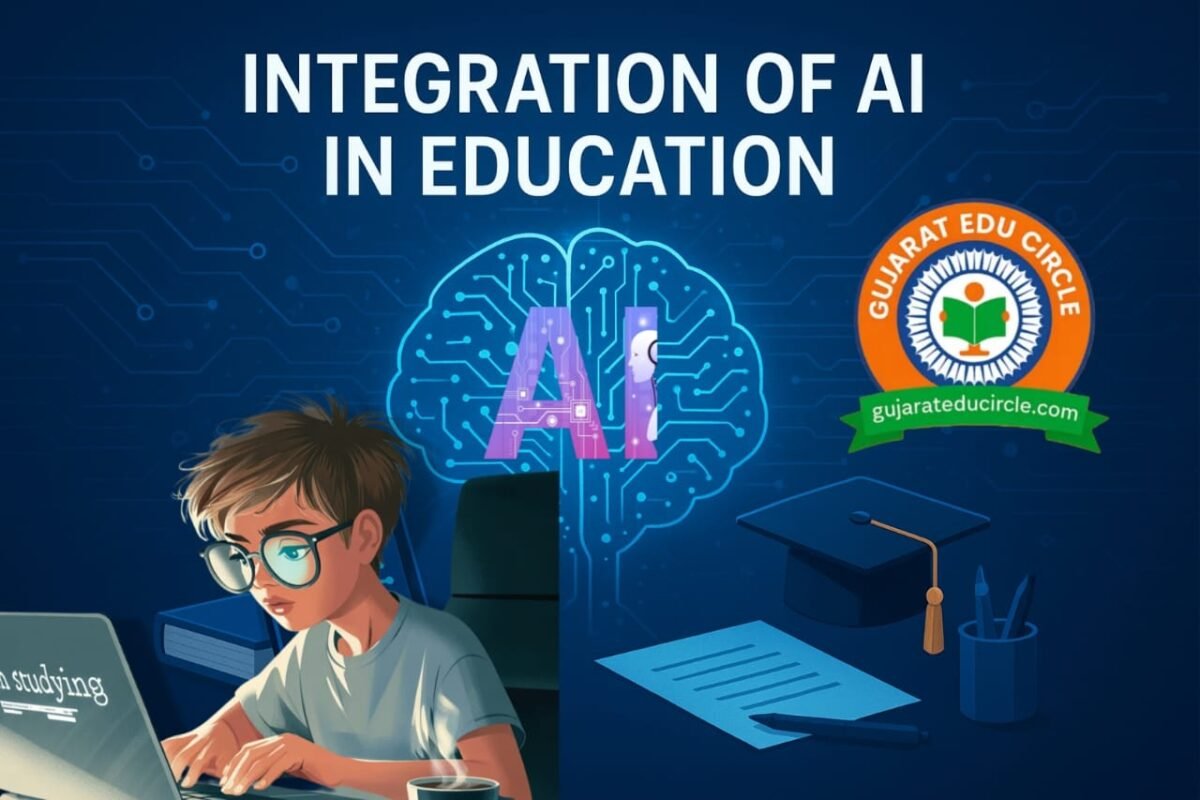integration of Technology of and AI in Education. Find out how technology and AI are revolutionizing education in Gujarat. Read about benefits, challenges, and the future of smart learning in schools and colleges.
Integration of Technology and AI in Education is revolutionizing the learning process. From intelligent classrooms to customized study aids, AI is opening doors of opportunities for students as well as teachers. Let’s see how these technologies are changing education in Gujarat and India.
About Us – gujarateducircle.com
gujarateducircle.com is a pioneer education website that is committed to bringing informative updates, information, and guidance to students, teachers, and institutions of Gujarat. We aim at bringing the learner together with current technology trends, education policy, and career prospects. We are concerned with ed-tech innovations — ranging from AI-based tools to e-learning platforms — to enable Gujarat’s students to be ahead of their peers in this digital age.
Integration of Technology and AI in Education
The education sector is going through a huge revolution that’s being led by Artificial Intelligence (AI) and new-age educational technology (EdTech). Be it a school in Ahmedabad or a university in Gandhinagar, technology is now an inevitable part of the education system.
The use of AI in education has improved teaching, made learning more interactive, and made management more effective. Technologies like AI-based tutors, smart classrooms, and online learning portals have become a necessity in Gujarat and Indian schools and colleges.
Role of Technology and AI in Education
Personalized Learning Experience
Each learner has an individual pace and learning style. AI detects these patterns and adapts lessons to fit. Adaptive environments such as Byju’s or Khan Academy employ AI to personalize quizzes, assignments, and learning modules so each student moves forward in a productive manner.
Bridging the Education Gap
In Gujarat’s rural regions, where quality teachers or facilities are not available, technology fills the void. AI-based tools and virtual classes enable students in isolated villages to learn high-quality lessons whenever and wherever they want.
Smarter Classrooms and Digital Transformation
The old blackboard is giving way to smart boards, AR/VR laboratories, and interactive simulations. They make learning more pictorial, interactive, and simple to grasp — particularly in subjects related to STEM (Science, Technology, Engineering, Mathematics).
Data-Driven Insights for Teachers
AI processes student performance and delivers insights to instructors. It enables educators to spot trouble spots, forecast results, and refine their teaching approach to enhance outcomes.
24/7 Learning and Accessibility
With digital platforms and smartphone apps, education is no longer limited to class rooms. Students can study at any time — and education becomes more flexible and accessible.
Benefits of AI and Technology in Education
Increased Student Engagement
Interactive videos, quizzes, and gamified course modules engage students and make them learn enthusiastically.
Automation of Administrative Tasks
AI systems can manage attendance, grading, and feedback, freeing up precious time for teachers and school administrators.
Personalized Feedback and Assessments
Instant feedback from AI teaches students where they go wrong and learn better.
Global Learning Opportunities
With online learning communities and webinars, students can now learn from peers, experts, and educators worldwide.
Increased Accessibility for Special-Needs Students
Speech recognition and text-to-speech systems based on AI enable students with disabilities to access education easily.
Cost-Effective and Scalable Solutions
Online platforms can host thousands of students at a fraction of the cost of traditional methods, making quality education more accessible.
Disadvantages and Challenges
Digital Divide
Though there is great internet connectivity in Ahmedabad and Vadodara, rural Gujarat continues to struggle with connectivity, restricting access to digital learning tools.
Over-Dependence on Technology
Students might over-depend on devices, diminishing their creativity, problem-solving skills, and face-to-face social skills.
Data Privacy Concerns
The application of AI entails capturing personal data, which poses privacy and security issues if not handled well.
High Investment Costs for Institutions
Implementation of AI-based systems, digital laboratories, and intelligent infrastructure may be costly for low-budget schools.
Teacher Training Required
Most teachers are yet to be familiar with AI-based systems. Technology integration may be ineffective or underutilized if not appropriately trained.
| Advantages | Disadvantages |
|---|---|
| 1. Personalized Learning – Adapts lessons to each student’s needs and pace. | 1. Over-Dependence on Technology – Reduces creativity and critical thinking. |
| 2. Improved Efficiency – Automates grading, attendance, and progress tracking. | 2. High Cost & Digital Gap – Rural areas face access and affordability issues. |
| 3. 24/7 Learning Access – Enables flexible, self-paced education. | 3. Lack of Human Interaction – Cannot replace teachers’ emotional guidance. |
| 4. Inclusive Learning – Supports students with disabilities through assistive AI tools. | 4. Data Privacy Concerns – Risk of misuse of student information. |
Future of AI and Technology in Education
The future of education in Gujarat and India is looking rosy digital. Artificial Intelligence will soon help teachers with predictive analytics, advise students with career guidance, and enhance learning with Augmented Reality (AR) and Virtual Reality (VR).
Additionally, the National Education Policy (NEP 2020) focuses on digital literacy, AI learning, and technology-based education — suggesting this transformation is here to stay.
Some AI that you should use them
chatGPT www.chatgpt.com
perplaxity www.perplaxity.ai
Conclusion
Technology and AI Integration in Education is not only a trend — it’s the future. It equips students with the ability to learn at their own pace, helps teachers with intelligent tools, and provides global opportunities for educational development.
Yet, to realise the full value of this digital revolution, Gujarat’s institutions have to guarantee equitable access, data protection, and adequate preparation for teachers. With technology and human wisdom complementing each other, education gets more inclusive, more effective, and future-proof.
At gujarateducircle.com, we envision that the convergence of AI and education will create a smarter, more interconnected generation of students prepared to navigate tomorrow’s digital world.

